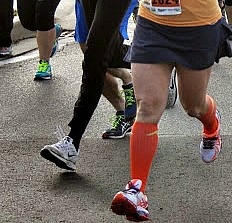In forefoot running, the legs act like shock absorbers to protect the shin bone, thereby preventing shin splints.
Preventing Shin Splints with Forefoot Running
In forefoot running, ankle plantarflexion occurs at touchdown and appears to be the pinnacle of impact reduction.
- When the ankle is plantarflexed at touchdown, the dorsiflexors rapidly lengthen (m. tibialis anterior) and energy absorption at touchdown during running is of this muscle [1].
Below is a video of Craig Mottram, a forefoot runner, demonstrating ankle plantarflexion at touchdown.
- Ankle plantarflexion at touchdown means that the forefoot is neither lifted up or pointed down upon or at foot strike. Therefore, the forefoot is aligned parallel with the ground upon touchdown.
- Notice that Craig lets his forefoot flop effortlessly to the ground –this is ankle plantarflexion. By the time his forefoot strikes the ground, the tibialis anterior will have lengthened, helping reduce impact.
In summary, ankle plantarflexion at touchdown in forefoot running allows the tibialis anterior to lengthen increases, which increases energy absorption, causing impact to be lower [1]. The opposite however, is seen in heel strike running.
Heel Striking Causes Shin Splints

Earlier work has found that heel strike runners are more likely to suffer a tibial stress fracture compared to forefoot runners. Why?
In order to heel strike, ankle dorsiflexion must occur, thereby shortening the tibialis anterior, causing impact to be greater.
The principled theory is that the impact forces that contribute to lower leg bone fractures are mainly determined by initial foot orientation at touchdown. The findings of the current study highlights this theory such that foot strike pattern determines the fate of a runners health.
The Take Home Message
It makes sense that responsibility for impact absorption resides in foot orientation (foot strike pattern) at touchdown when running because the touchdown phase is presumed to cause the highest amount of impact.
Furthermore, we take our foot strike pattern for granted because it usually seems so effortless. However, certain footwear has selective, yet profound disturbances in foot orientation at touchdown, that we begin to appreciate the role of the proper foot strike (forefoot strike) in protecting the entire body from impact-related damage.
More From Run Forefoot:
Bad Footwear – Running shoes that increase your risk of heel striking while you run.
Midfoot Striking – Find out why running with a midfoot strike is not as good as running with a forefoot strike.
Beware of Plantar Loading – Too much plantar pressure is linked to overuse injuries of the leg.
Top Shoes for Forefoot Running – Find out the best running shoes for forefoot running.
Daily Deals on Minimalist Shoes (Less is more, but not in terms of money):
Men’s New Balance 20v3 – Reg. 100, Now 55
Men’s Vibram FiveFingers Bikila EVO – Reg. 120, Now 95.93
Men’s Vibram FiveFingers KSO EVO – Reg. 90, Now 71.93
Men’s Vibram FiveFingers Spyridon MR – Reg. 120, Now 95.93
References:
[1]. Karin et al. Direct dynamics simulation of the impact phase in heel-toe running. J Biomech, 1995; 28(6):661-668.
Bretta Riches
BSc Neurobiology; MSc Biomechanics candidate, ultra minimalist runner & founder of RunForefoot. I was a heel striker, always injured. I was inspired by the great Tirunesh Dibaba to try forefoot running. Now, I'm injury free. This is why I launched Run Forefoot, to advocate the health & performance benefits of forefoot running and to raise awareness on the dangers of heel striking, because the world needs to know.
Latest posts by Bretta Riches (see all)
- Forefoot Running and Achilles Pain - 19/04/2024
- Does Foot Strike Really Matter in Running? YES! - 17/04/2024
- Heel Lifts Increase Injury in Runners - 16/04/2024

Leave a Reply